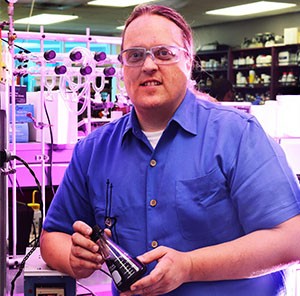Dr. Richard Blair on Catalysts
It all started with a doodle.
Richard Blair, Ph.D., Research Professor in Physics and the Center for Advanced Turbomachinery and Energy Research (CATER), had been at UCF for three years when he started doodling during a seminar. He was working on a project, upgrading bio-based oils for use as jet fuels. Without processing, these fuels contained too much oxygen to be useful, but through hydrodeoxygenation, where a catalyst adds hydrogen to remove oxygen, they can be used. As he drew the components of unprocessed biofuel (carboxylic acids and their esters), he wondered if boron nitride could work similarly in hydrogenation. According to the doodle, it should work, but as Blair said, “The devil’s in the details. Just because it might work on paper, doesn’t mean it’s going to work instantly.”
After years of research, Blair’s hunch was finally confirmed. He explained: “Every aspect of our life is touched by a catalyst. If we didn’t have catalysts, we wouldn’t have the world we have today. Unfortunately, a lot of the catalysts that are currently in use have some problems. And a big problem is that something like Crisco is made using a nickel-based catalyst, partly because of cost. A little bit of that nickel can leech into the Crisco and that is cause for concern. Some people have linked that to cardiovascular disease.”
Boron nitride exists in several forms. It can crystallize into a cubic form, which is colorless, but it often looks like smoky quartz or amber where it is second only to diamond in hardness. It chemically acts like a metal in hydrogenation, but without all the drawbacks of contamination. And, it’s cheaper. Boron is mined in the eponymous small town in Southern California, so there is no need to import it from countries such as Canada and China.
—
Back to the doodle: carboxylic acids and their esters look a lot like carbon dioxide. So Blair thought that the same hydrogenation process might work with carbon dioxide. There’s a growing, urgent need to find a way to address excess carbon dioxide emissions. Carbon dioxide is known as a greenhouse gas and has led to increasingly higher temperatures and climate change. This past July was the hottest month on record. In August 2015, the Obama administration announced a Clean Power Plan that aims to reduce carbon dioxide emissions by 32 percent from 2005 levels by 2030.
Blair explained: “The killer application is that this same catalyst can do something that no other catalyst can do, which is convert carbon dioxide into usable molecules like fuels [e.g. formic acid, methanol, ethanol, propanol, and butanol] and precursor chemicals, chemicals to make plastics and to make everyday items, [such as pharmaceuticals]. There are catalysts that people are investigating that do that, but they always need to add solar energy or electricity… What I’ve identified is a simple approach that uses a relatively inexpensive catalyst to do what all these more complicated catalysts do.”
—
Blair was drawn to UCF because of the cooperation with the Office of Technology Transfer and the Office of Research and Commercialization, specifically the desire to move innovations to commercialization. He finds that the university environment also supports the freedom to explore new ideas, just as he did as a post-doc.
In his post-doctoral studies, Blair worked with others across disciplines: “You could say it’s the scientific equivalent of a liberal arts education,” he remarked. The same spirit of interdisciplinary research guides Blair’s work at UCF. He credits this current invention to the strong collaboration with Talat S. Rahman, Ph.D., Department Chair and Pegasus Professor of Physics, Laurene Tetard, Ph.D., Assistant Professor of Physics, Jay Kapat, Ph.D., Professor of Mechanical and Aerospace Engineering and Director of CATER, and James Harper, Ph.D., Assistant Professor of Chemistry. Blair also has partnered with companies like Saint-Gobain, which provides him with boron nitride, and Applied Porous Technologies, which provide the tiny filters critical for the proper functioning of the reaction vessels he uses. Blair is currently working with Rahman, Masahiro Ishigami, Ph.D., Associate Professor of Physics, and William Kaden, Ph.D., Assistant Professor of Physics, on a new catalyst for producing ammonia.
—
Through some idle doodling, dogged determination, and inspired collaboration, Richard Blair has discovered a technology that can lead the planet to a healthier future.
To learn more about this and other technologies of Blair’s available for licensing, check out the Technology Locator and read this month’s Patent Trending Blog.
